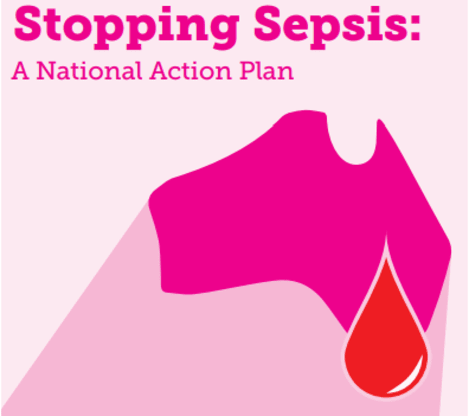
STOPPING SEPSIS NATIONAL ACTION PLAN (SSNAP)
In 2018 the Australian Sepsis Network and The George Institute for Global Health launched the National Action Plan to reduce the number of people who lose their lives each year to sepsis – a life-threatening condition that occurs when the body’s response to infection injures tissues and organs.
Summary of key recommendations from the round-table:
- Establish a nationally-coordinated sepsis body to facilitate the action plan
- Invest in prevention and awareness campaigns to spur action within the community
- Establish and implement a nationally recognised clinical standard for sepsis detection and treatment
- Invest in community and peer support services for sepsis survivors and their families.
The action plan is backed by the Australian Commission on Safety and Quality in Health Care, the Australian and New Zealand Intensive Care Society and the NSW Clinical Excellence Commission as well as leading health policy professionals and sepsis survivors.
Professor Simon Finfer, head of the Australian Sepsis Network, said that whilst sepsis was often difficult to detect, it can be prevented and treated successfully if diagnosed quickly. “Sepsis kills more Australians each year than breast or prostate cancer, but there’s no public outcry about this, or national campaign to reduce the shockingly high death rate.
“Sepsis can be prevented and, in many cases, can be treated successfully. We need to ensure that when patients present with symptoms they receive the best care possible, and that treatment begins as quickly as possible,” said Professor Finfer.
Sepsis is estimated to cost Australia $4.7 billion each year with many cases beginning in the community rather than in hospitals. For those that survive, half are left with a disability or impaired function that also impacts their family and friends.
The national action plan is a call for increased and coordinated efforts to raise awareness of sepsis, improve diagnosis and treatment, and provide greater support for Australians who have experienced sepsis. Sepsis Australia is working towards implementing these recommendations through the National Sepsis Program in collaboration with the Australian Commission on Safety and Quality in Health Care and by supporting health services adopting the national Sepsis Clinical Care Standard.
Video rights: ACSQHC
NATIONAL SEPSIS PROGRAM
On 13 September 2019, Minister Hunt announced $1.5 million in funding for The George Institute Sepsis Australia to support improved sepsis outcomes. The Australian Government Department of Health engaged The George Institute Sepsis Australia in partnership with the Australian Commission on Safety and Quality in Health Care to lead and coordinate the National Sepsis Program through a funding agreement to June 2022. The program aimed to improve outcomes for people with sepsis in Australia by:
- Improving the recognition of sepsis in all settings (primary, subacute, acute)
- Providing clinicians with nationally agreed sepsis clinical guidance materials
- Strengthening the comprehensive care planning process for sepsis survivors.
In 2022, the Australian Government Department of Health allocated a further $2.1 million for the National Sepsis Program Extension to build on the achievements and ongoing work on sepsis nationally with a focus on:
- Developing a national awareness campaign about sepsis
- Developing sepsis education resources for health programs and health professionals
- Developing a model of coordinated sepsis care and post sepsis support for survivors and families
- Developing and publishing data collection tools for hospitals and healthcare services to drive improvements to sepsis care models
- Improving awareness and recognition of risk, identification and response to sepsis for First Nations peoples.

NATIONAL SEPSIS CLINICAL CARE STANDARD
The Sepsis Clinical Care Standard ensures that a patient presenting with signs and symptoms of sepsis receives optimal care, from symptom onset through to discharge from hospital and survivorship care. Sepsis is a life-threatening condition that arises when the body’s response to an infection damages its own tissues and organs.
The Sepsis Clinical Care Standard will help to ensure sepsis is recognised early and patients receive coordinated, best-practice care so that the risk of death or ongoing morbidity is reduced. This includes timely recognition of sepsis, early and appropriate antimicrobial therapy and continuity of care from the acute setting through to discharge and survivorship.
The Sepsis Clinical Care Standard contains:
- Seven quality statements describing the care that should be provided
- A set of indicators to support monitoring and quality improvement
The clinical care standard provides guidance for consumers, clinicians, and healthcare services including information about what each statement means, and a series of implementation resources.
Implementation resources have been developed to support the implementation of the Sepsis Clinical Care Standard. These include guidance around the use of antimicrobials and lactate, patient information resources, and discharge planning tools and resources. A number of case studies illustrate best practice and innovation in sepsis care. Stay tuned for more resources including podcasts, and slide decks discussing key aspects of the Sepsis Clinical Care Standard.
You can also find links to relevant related resources, including sepsis resources from states and territories around Australia.
The standard was developed in consultation with a topic working group of clinicians, researchers and consumers. Public consultation on the clinical care standard was carried out between August and September 2021. The standard has been endorsed by 26 key professional associations and consumer organisations including the Australasian College for Emergency Medicine (ACEM), the College of Intensive Care Medicine of Australia and New Zealand (CICM), the Council of Remote Area Nurses (CRANAplus), the Australian Sepsis Network (ASN) and the National Aboriginal Community Controlled Health Organisation.
Further information is available on the evidence base which underpins the Sepsis Clinical Care Standard, and the rapid literature and evidence review commissioned to inform the standard’s development.

The Bangkok Declaration
Background
The Bangkok Declaration is a call to action for a regional alliance to reduce the burden of sepsis in the Asia Pacific region. The inaugural Asia Pacific Sepsis Alliance (APSA) meeting was held in Bangkok, Thailand, on 4 October 2018. Delegates from 12 countries called for urgent action by governments, policymakers, health services, researchers, funding agencies, and the community to support national and international commitments to improve the prevention, diagnosis, and treatment of sepsis and to dedicate human and financial resources towards these goals. This document provides detail on the Bangkok Declaration 2018, Steering Committee Terms of Reference, APSA Workgroups and activities, and program management requirements.
The Bangkok Declaration
Sepsis is one of the most common, least-recognized illnesses in the developed and developing world resulting in a death every few seconds.
Death and disability from sepsis is preventable through early recognition and treatment
Sepsis is a major cause of preventable deaths in the Asia Pacific region and is the most common cause of death from infection. This Bangkok Declaration is a call to action for a regional alliance to reduce the burden of sepsis. The inaugural Asia Pacific Sepsis Alliance (APSA) meeting was held in Bangkok, Thailand, on 4 October 2018. Delegates from 12 countries called for urgent action by governments, policymakers, health services, researchers, funding agencies, and the community to support national and international commitments to improve the prevention, diagnosis, and treatment of sepsis and to dedicate human and financial resources towards these goals.
The Bangkok Declaration acknowledges:
- The World Health Organisation (WHO) recognized sepsis as a global health priority in 2017 through a World Health Assembly (WHA) resolution urging member nations to adopt national action plans
- Coordinated global, regional, and national approaches are needed to improve the prevention, recognition, and treatment of sepsis and to support sepsis survivors and those bereaved by sepsis
- The goals of the Global Sepsis Alliance (GSA) to:a. Place sepsis on national health agendas by raising political awareness of the growing health and economic burden of sepsisb. Ensure that treatment facilities, support programs, and well-trained staff are available for acute and long-term carec. Support the implementation of international sepsis guidelinesd. Mobilize stakeholders to ensure that strategies to prevent and control the impact of sepsis are targeted at those who are most in neede. Involve sepsis survivors and those bereaved by sepsis in planning strategies to decrease sepsis incidence and improve sepsis outcomes
- There is wide variation among Asia-Pacific populations and healthcare services that need to be addressed in national plans to target interventions and reduce inequity
- That despite the unacceptable number of deaths and disabilities caused by sepsis, awareness among healthcare providers and the public in Asia-Pacific countries is very low.
Collaboration
Sepsis Australia operates within an ecosystem of health and sepsis focused organisations and individual champions all working towards reducing the burden of sepsis. The Global Sepsis Alliance and its Regional Alliances, the International Sepsis Forum and the World Health Organisation provide international leadership in advocating for sepsis, developing strategic action plans and resources, and disseminating knowledge on best practices in sepsis prevention, treatment and support.
Global Sepsis Alliance (GSA) is a non-profit charity organisation with the mission to provide global leadership to reduce the worldwide burden of sepsis. The GSA is the initiator of World Sepsis Day on September 13 and World Sepsis Congress, a series of free online congresses bringing knowledge about sepsis to all parts of the world, among other initiatives. The GSA works closely with its over 115 member organisations from all over the world – patient advocacy groups, professional societies, healthcare authorities, and governments – to implement changes on how sepsis is prioritised, diagnosed, and treated all around the world, as laid out in the WHO Resolution on Sepsis.
The Asia Pacific Sepsis Alliance was formed in Bangkok, Thailand in October 2018. The APSA is collaborating closely with the Global Sepsis Alliance, an international non-profit charity organisation.
World Health Organisation recognised sepsis as an important global health threat and responded with a WHO Secretariat Report in May 2017 to the Seventieth World Health Assembly which adopted Resolution WHA70.7 on Improving the prevention, diagnosis and clinical management of sepsis.
The key pillars of Resolution WHA 70.7 are to:
- develop WHO guidance on sepsis prevention and management;
- draw attention to public health impacts of sepsis and estimate the global burden of sepsis;
- support Member States to define and implement standards and establish guidelines, infrastructure, laboratory capacity, strategies, and tools for identifying, reducing incidence of, and morbidity and mortality due to sepsis; and
- collaborate with UN organizations, partners, international organizations, and stakeholders to enhance sepsis treatment and infection prevention and control including vaccinations.
In collaboration and coordination with WHO regional offices, Member States and other stakeholders, several WHO headquarters programmes are currently working on the public health impact of sepsis and providing guidance and country support on sepsis prevention, early and appropriate diagnosis, and timely and appropriate clinical management. Through the GSA and APSA, Sepsis Australia is contributing to this important work which is harnessing global collaboration to tackle sepsis.
See: https://www.who.int/news-room/fact-sheets/detail/sepsis
Locally Sepsis Australia on proactive coordination and collaboration with multiple partners and organisations to undertake our work towards achieving our mission.
